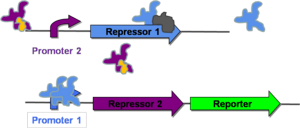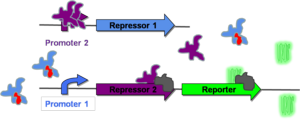Error creating thumbnail: Unable to save thumbnail to destination
Biological Models
Overview
Thus far in the construction of various synthetic cellular memory devices, two main biological models have been used by researchers: mutual repression and autoregulatory positive feedback. Both of these models produce two stable levels at which a reporter protein can exist in a given cell. Based on a given input, both models balance reporter protein concentrations to one of these two stable states (typically "on" or "off"), determined by the configuration of genes and promoters in the system. Both the mutual repression model and the autoregulatory positive feedback model are found in natural systems, but each equips a synthetic device with different capabilities. The mutual repression model works by turning off expression of one or more constitutively expressed genes based on an input, while autoregulatory positive feedback turns on one or more constitutively repressed genes based on an input.
Mutual Repression
 Figure 1: Depiction of a mutual repression system in the "off" state.  right Figure 2: Depiction of a mutual repression system in the "on" state. Put text here.
Error creating thumbnail: Unable to save thumbnail to destination
Autoregulatory Positive Feedback
<Previous Section | Next Section>
|